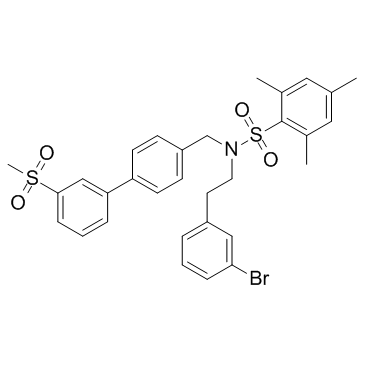| Description |
SR9243 is a liver-X-receptor (LXR) inverse agonist that induces LXR-corepressor interaction.
|
| Related Catalog |
|
| In Vitro |
SR9243 specifically targets LXR and downregulates LXR-mediated gene expression, dose-dependently suppresses LXRα- and LXRβ-dependent transcription at nanomolar concentrations, and potently inhibits LXR-driven luciferase activity in cultured cancer cells. SR9243 potently reduces cancer cell viability at nanomolar concentrations (IC50 appr 15-104 nM) in prostate (PC3 and!DU-145), colorectal (SW620 and HT29), and lung (HOP-62 and NCI-H23) cancer cell lines. And the colony-forming capacity of cancer cells is also significantly loared by SR9243 in a dose-dependent manner. SR9243 is a potent inhibitor of lipogenic gene expression that selectively kills cancer cells by depleting intracellular lipids. Combination of cancer cell media with oleate, stearate, and palmitate in combination completely rescues cancer cell viability in cancer cells. Fatty acid supplementation also rescues the viability of SW620 cells in which glycolysis is substantially disrupted[1].
|
| In Vivo |
SR9243 is able to profoundly inhibit tumor glycolysis, lipogenesis, and induce apoptotic cancer cell death without promoting weight loss in vivo. SR9243 inhibits tumor growth without profoundly repressing glycolytic gene expression, and inhibits tumor growth and lipogenesis without hepatotoxicity or inflammation in vivo[1].
|
| Cell Assay |
Cancer cells are plated at low-density (5×103) cells per well. Cells are then treated with either DMSO vehicle control, SR9243 (100 nM) or SR9243 (10 μM) and allowed to grow for 4 days. Colonies are then fixed with Formaldehyde (1%) and stained with Crystal violet solution (0.05% w/v)[1].
|
| Animal Admin |
Mice[1] C57BL/6J, Nu/Nu and Ob/Ob mice are used in the assay. Mice are housed in sterile ventilated cages, fed a standard diet, and provided water ad libitum. Mice are treated after two weeks of acclimation. Mice are monitored daily for signs of illness, pain, or severe weight loss. All mice are humanely euthanized using CO2 followed by cervical dislocation. For liver lipid content analysis 8-week old male Ob/Ob mice are fed a high fat diet (60% kcal/fat, 20% carbohydrate) for the duration of the experiment and are treated with vehicle or SR9243 for 3 days. Mice are injected (i.p.) with either vehicle (10% DMSO, 10% Tween-80) or SR9243 (30 mg/kg) once daily[1].
|
| References |
[1]. Flaveny CA, et al. Broad Anti-tumor Activity of a Small Molecule that Selectively Targets the Warburg Effect and Lipogenesis. Cancer Cell. 2015 Jun 24. pii: S1535-6108(15)00183-X.
|
